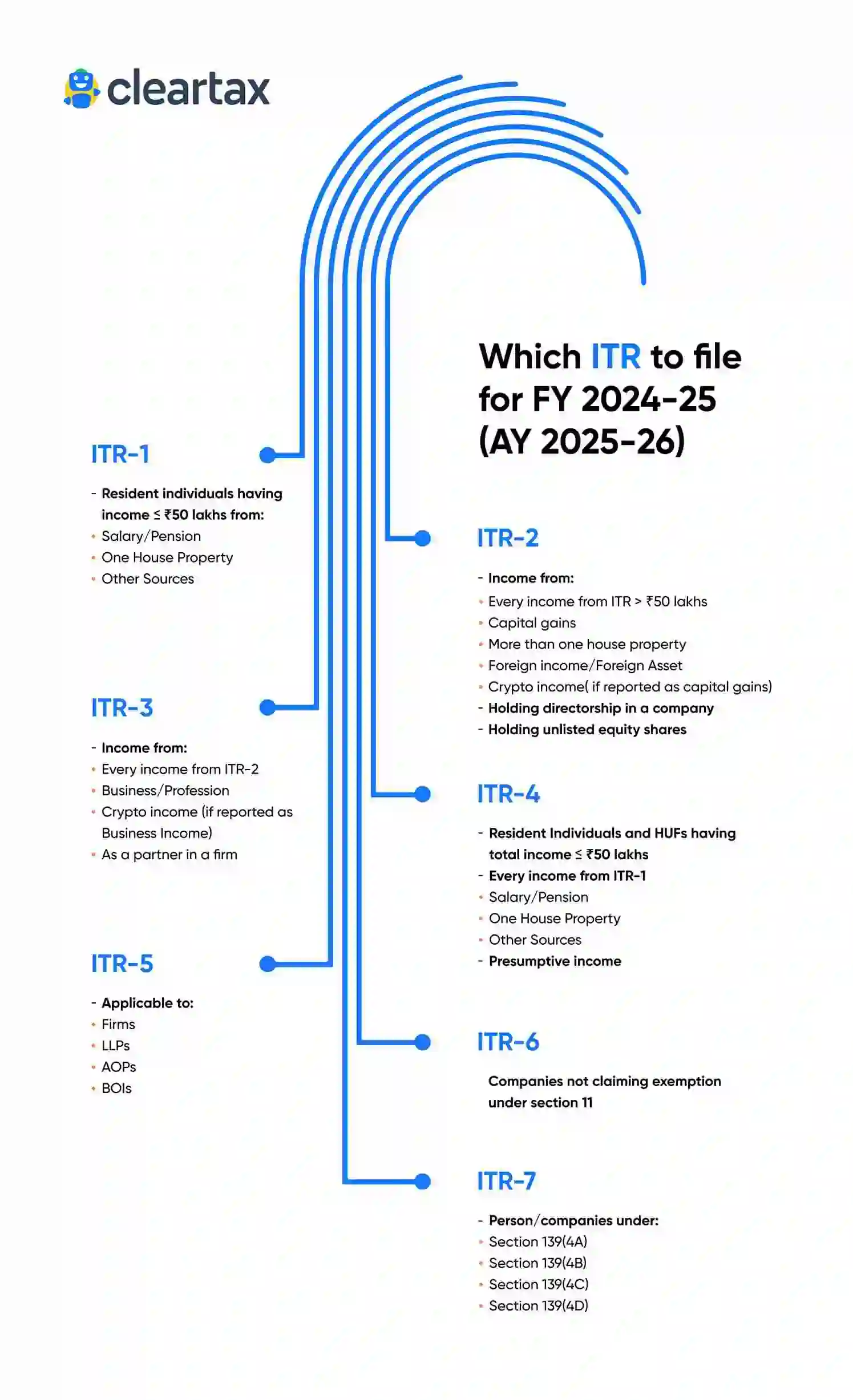Which ITR to File in FY 2024-25? Types of ITR Forms and Applicability
There are various types of ITR forms, applicable specifically for different kinds of taxpayers, based on their sources of income, residential status, level of income, legal status of the taxpayer (individual, firm, company), etc.,
Key Highlights
The ITR form applicable depends on the type and amount of income of the taxpayer as follows:
- ITR 1: Salaried individuals with income up to Rs. 50 lakh
- ITR 2: Individuals with capital gains
- ITR 3: Income from business or profession
- ITR 4: Income From Business and Profession < Rs. 50 lakh
- ITR 5: Firms, LLPs, AOPs, and BOIs
- ITR 6: Companies
- ITR 7: Charitable trusts
What is ITR?
Income Tax Return (ITR) is a form used by taxpayers to report their income and taxes to the Income Tax Department. Filing must be done before the specified due date each year. There are seven ITR forms (ITR-1 to ITR-7), and the correct form depends on factors like income source, income amount, and taxpayer category (individual, HUF, company, etc.).
Different Types of ITR Forms
Applicability of different kinds of ITR forms are explained elaborately below.
ITR-1 or SAHAJ
Who Can use ITR-1?
A taxpayer can file under ITR-1, if the following conditions are satisfied.
- Resident individuals
- Total income not exceeding Rs. 50 lakh
- Income from Salary/ Pension; or
- Income from One House Property (excluding cases where loss is brought forward from previous years); or
- Income from Other Sources (excluding Winning from Lottery and Income from Race Horses)
- Long-term capital gains income u/s 112A up to Rs. 1.25 lakhs (having no brought-forward or carry-forward capital loss)
- Agricultural income up to Rs 5,000.
Who Cannot use ITR-1 Form?
- Total income exceeding Rs 50 lakh
- Agricultural income exceeding Rs 5000
- If you have taxable capital gains
- If you have income from business or profession
- Having income from more than one house property
- If you are a Director in a company
- If you have investments in unlisted equity shares at any time during the financial year
- Owning assets (including financial interest in any entity) outside India, including signing authority in any account located outside India
- If you are a Resident-not-Ordinarily Resident (RNOR) and Non-Resident
- Having any foreign income
- If tax has been deducted under Section 194N
- If in case payment or deduction of tax has been deferred on ESOP
- If you have any brought forward loss or loss needs to be carried forward under any income head
ITR-2
Who Can use ITR-2?
A taxpayer can file under ITR-2, if the following conditions are satisfied.
- Income from Salary/Pension
- Income from House Property
- Income from Other Sources (including Winnings from Lottery and Income from Horse Races)
- If you are an Individual Director in a company
- If you have had investments in unlisted equity shares at any time during the financial year
- Being a Resident-not-Ordinarily Resident (RNOR) and Non-Resident
- Income from Capital Gains
- Having any foreign income
- Agricultural income more than Rs 5,000
- Owning assets (including financial interest in any entity) outside India, including signing authority in any account located outside India
- If tax has been deducted under Section 194N
- If in case payment or deduction of tax has been deferred on ESOP
- If you have any brought forward loss or loss needs to be carried forward under any income head
Further, in a case where the income of another person like one’s spouse, child etc. is to be clubbed with the income of the assessee, this Return Form can be used where such income falls in any of the above categories. The total income can be more than Rs 50 Lakhs.
Who Cannot use ITR-2?
Tax payers with Income from Business or Profession cannot file ITR-2.
ITR-3
Who Can use ITR-3?
A taxpayer can file under ITR-3, if the following conditions are satisfied.
- Individual or HUF
- Having Income From Business and Profession (both presumptive taxation and audit cases)
- If you have had investments in unlisted equity shares at any time during the financial year
- The return may include income from House property, Salary/Pension, and Income from other sources
- Income of a person as a partner in the firm
Who Cannot file ITR-3?
- Companies
- Business and charitable trusts
- Partnership firms, AOPs, BOIs, etc.,
In short, individuals or HUFs who are not eligible to file ITR-1, ITR-2, and ITR-4 should file ITR-3
ITR 4 or Sugam
ITR-4 (also known as Sugam) is the Income Tax Return form for individuals, Hindu Undivided Families (HUFs), and firms (other than LLPs) who have opted for the presumptive income scheme under Section 44AD, 44ADA, or 44AE of the Income Tax Act.
Who Can use ITR-4?
A taxpayer can file under ITR-4, if the following conditions are satisfied.
- Resident individuals.
- Total income not exceeding Rs. 50 lakh
- Business and professional income
- Income from salary or pension
- Income from one house property (excluding the amount of brought forward loss or loss to be carried forward)
- Income from other sources (excluding income from lottery and race-horses )
- Long-term capital gains income u/s 112A up to Rs. 1.25 lakhs (having no brought-forward or carry-forward capital loss)
Please note that any individual earning income from the above-mentioned sources as a freelancer can also opt for the presumptive taxation scheme if their gross receipts are not more than Rs. 50 lakhs.
A presumptive income scheme under sections 44AD, 44AE, and 44ADA is when an individual or an entity opts to derive its income on a presumptive basis, i.e. when the income is presumed at a minimum rate based on a percentage of gross receipts / gross turnover or based on ownership of commercial vehicles. However, if the business turnover exceeds Rs 2 crore, the taxpayer will have to file ITR-3.
Who Cannot use ITR-4 Form?
- If your total income exceeds Rs 50 lakh
- Having income from more than one house property
- Owning any foreign asset
- If you have signing authority in any account located outside India
- Having income from any source outside India
- If you are a Director in a company
- If you have had investments in unlisted equity shares at any time during the financial year
- Being a resident not ordinarily resident (RNOR) and non-resident
- Having foreign income or assets
- If you are assessable in respect of the income of another person in respect of which tax is deducted in the hands of the other person.
- If in case payment or deduction of tax has been deferred on ESOP
- If you have any brought forward loss or loss needs to be carried forward under any income head
ITR-5
Who Can file ITR-5?
ITR-5 is the Income Tax Return form applicable to:
- Partnership firms
- Limited Liability Partnership (LLP)
- Association Of Persons (AOP)
- Body Of Individuals (BOI)
- Other similar entities
Who Cannot file ITR-5?
- Entities other than individuals
- HUFs
- Companies
- Taxpayers eligible for filing ITR-7
ITR-6
Who Can file ITR-6?
ITR-6 is the Income Tax Return form applicable to companies.
Who Cannot file ITR-6?
Taxpayers those claiming exemption under Section 11: Income from property held for charitable or religious purposes.
ITR-7
ITR-7 is the Income Tax Return form applicable to persons (including companies) who are required to file returns under sections 139(4A), 139(4B), 139(4C), or 139(4D) of the Income Tax Act, primarily related to charitable, religious, and specified institutions.
- Return under section 139(4A) is required to be filed by every person in receipt of income derived from property held under trust or other legal obligation wholly for charitable or religious purposes or in part only for such purposes.
- Return under section 139(4B) is required to be filed by a political party if the total income without giving effect to the provisions of section 139A exceeds the maximum amount, not chargeable to income-tax.
- Return under section 139(4C) is required to be filed by every –
- Scientific research association;
- News agency;
- Association or institution referred to in section 10(23A);
- Institution referred to in section 10(23B);
- Fund or institution or university or other educational institution or any hospital or other medical institution.
- Return under section 139(4D) is required to be filed by every university, college or other institution, which is not required to furnish a return of income or loss under any other provision of this section.
- Return under section 139(4E) must be filed by every business trust which is not required to furnish a return of income or loss under any other provisions of this section.
- Return under section 139(4F) must be filed by any investment fund referred to in section 115UB. It is not required to furnish a return of income or loss under any other provisions of this section.

Which ITR Form to File?
Choosing the correct ITR form depends on your income type, taxpayer category, and income level. For example, ITR-1 is for salaried individuals with income up to ₹50 lakh, while ITR-3 is for those with business or professional income. Knowing the right ITR form helps ensure accurate and hassle-free filing with the Income Tax Department.
The below table offers details about which ITR form to file and the eligibility for such ITR forms:
| ITR Form | Who Can File | Who Cannot File |
| ITR-1 (Sahaj) | Resident individuals with income up to ₹50 L from salary/pension, one house property, other sources (interest, etc.), and agricultural income ≤ ₹5,000; and LTCG up to ₹1.25 L from equity/mutual funds. | NRIs, residents with >₹50 L income, multiple properties, capital losses carry‑forward, business income, foreign assets, company directors, ESOP holders, Income chargeable in special tax rates. |
| ITR-2 | Individuals/HUFs (including NRIs/RNORs) with salary/pension , capital gains (any amount), multiple house property income, foreign income/assets, agricultural income > ₹5,000, unlisted shares, ESOPs, company directors | Individuals with business/professional income |
| ITR-3 | Individuals/HUFs with income from a proprietary business or profession, partners in firms (not LLPs), F&O trading, unlisted shares, plus salary, house property, capital gains | Companies, partnership firms and charitable trusts |
| ITR-4 (Sugam) | Resident individuals/HUFs/firms (excluding LLPs) opting for presumptive taxation under sections 44AD/44ADA/44AE, with income ≤ ₹50 L; Includes salary, one house property, equity LTCG ≤ ₹1.25 L | Business income where books of accounts are required to be maintained, and persons not eligible to file ITR-1 |
| ITR-5 | Firms, LLPs, AOPs, BOIs, local authorities, cooperative societies, estates, business trusts – all non-individual entities (excluding those required to file ITR‑7) | Individual or HUF taxpayers, companies |
| ITR-6 | Companies (other than those claiming exemption under section 11) | Trusts or institutions under section 11 |
| ITR-7 | Trusts, political parties, scientific/research institutions, universities, hospitals, NGOs, other institutions required under sections 139(4A)/(4B)/(4C)/(4D)/(4E)/(4F) | Individuals, HUFs, Firms, and companies not covered above |
Income Tax Form FY 2024-25 PDF Download: How To Download ITR 1, ITR 2, ITR 3, ITR 4, ITR 5, ITR 6 and ITR 7 Forms
| ITR Forms | Links |
| ITR-1 | Click here to download ITR-1 Form |
| ITR-2 | Click here to download ITR-2 Form |
| ITR-3 | Click here to download ITR-3 Form |
| ITR-4 | Click here to download ITR-4 Form |
| ITR-5 | Click here to download ITR-5 Form |
| ITR-6 | Click here to download ITR-6 Form |
| ITR-7 | Click here to download ITR 7 Form |
Other Forms required to File ITR
Form 16
- Form 16, is one of the most important documents in the ITR filing process.
- It is prepared annually, and is provided by the employer. It is divided into 2 parts, Part-A and Part-B.
- Part - A contains details of TDS deducted against your salary, whereas Part-B contains estimated total income, eligible deductions, estimated tax payable.
Form 26AS
- Form 26AS is a consolidated TDS statement, containing all the TDS deducted against the taxpayer throughout the year.
- Apart from that, it contains income against which TDS is deducted, full particulars of SFT transactions during the year, turnover of the assessee as per GST records, etc.,
AIS
- Annual Information Statement or AIS, is a comprehensive document that contains all the income earned by you as per the income tax records.
- It contains capital gains, dividend income, interest, salary, and other material financial transactions undertaken by you during the financial year.
Form 10-IEA, Form 10B are other popular forms that needs to be filed in specific circumstances to file ITR.
Also Read - Income Tax Slab and Rates for FY 2025-26
Frequently Asked Questions



